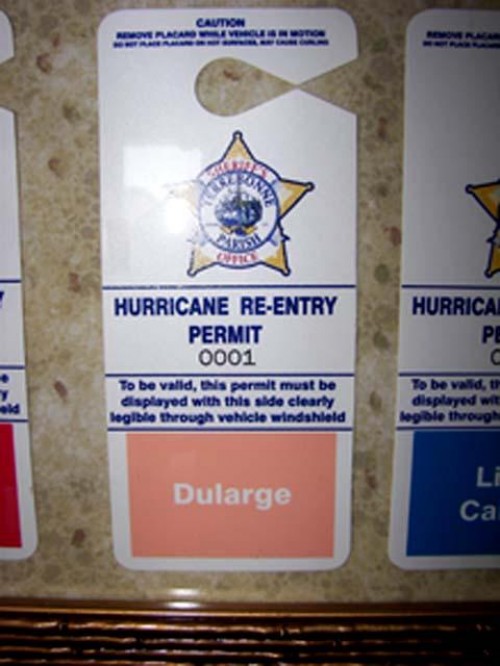Upcoming fishing rodeos
July 9, 2007Ray Fonseca
July 11, 2007Deciding whom to allow back into a parish following an evacuation in the days after a strong hurricane hits has long been a difficulty faced by local law enforcement officials along the Gulf of Mexico in Louisiana.
Parish officials are given priority, but residents are inevitably eager to evaluate any damage suffered by their homes.
Allowing residents to return “depends on the tidal surge, when the water subsides,” said Terrebonne Parish Sheriff Jerry Larpenter.
The sheriff’s office revived a badge re-entry program following Hurricane Katrina in 2005 in which identification cards, easily hung on a car’s rearview mirror, were issued to parish residents.
The tags, which cost $1, display numbers that have been previously stored in a computer. The backsides of the badges have hurricane preparation tips.
“It takes time to identify everyone coming through a roadblock,” Larpenter said. “You hang the tags on the rearview mirror, and just come through. We’ve done that since Katrina and Rita.”
“I’ve been working these hurricanes for 30 years, so I’ve seen what goes on and how it makes it easier to identify your people,” he explained.
When issuing the re-entry badges, the sheriff’s office makes a distinction between the Houma area in the northern part of the parish, and the southern portion of Terrebonne divided by several bayous.
The sheriff’s office distributes the tags primarily to residents of the southern end of the parish.
“If the city of Houma goes under, that means we’ve been hit with a three, four, or five category hurricane,” Larpenter said. “Surrounding parishes would be shut down. You’re going to have trees, and power lines on the road. You’ll have all kinds of destruction if the city of Houma goes under. But that hasn’t happened in the history of this city.”
“But if that does happen, these little tags won’t help nobody,” he said. “That means all low-lying areas are completely underwater.”
However, for the southern part of Terrebonne Parish, “We gave out thousands of badges to people on the bayous,” Larpenter said. “We’ve already implemented it. It’s on the computer.”
He said that the badges will help identify the many new residents moving to the lower end of Terrebonne Parish.
“We try to get deputies who know most of the people,” he said, but because of the influx of newer residents, “our officers don’t know everyone living on the bayou.”
“With Pointe-Aux-Chenes, and Montegut, and going to Dularge, we’re going to stop you, to see if you’re going to help relatives, and what business you have going there,” Larpenter said.
“If you don’t have a badge, we’re definitely going to stop you,” he said. “We want to keep sightseers out, people who have no business to be down in these areas.
“With businesspeople, we want to make sure businesses can get back up and running because that’s our lifeline, that’s jobs and tax dollars,” Larpenter said.
“Even if we get a category one or two storm, we’ll still have the same water Rita brought us,” he said. “Thousands of homes will be underwater. When people go back to their respective areas, we’ll know that they’re residents of that area.”
Larpenter said he began the badge re-entry program in the late 1980s when he headed Terrebonne Parish’s Emergency Operations Center.
“I was recognized in Emergency Operations Magazine in 1988 for having the first hurricane action plan in Louisiana,” he said. “We know what we’re doing when it comes to hurricane relief efforts.”
Larpenter said that Terrebonne Parish moved its Emergency Operations Center to the first floor of the Houma Police Department station, and the badge re-entry program lay dormant until hurricanes Katrina and Rita struck.
“I started (the badge re-entry program) again on my own,” he said.
Larpenter wants to move the parish’s EOC from the Houma Police building, where it has been located since 1997, to the Terrebonne Parish courthouse.
“If a big storm comes, they’d have to evacuate that place,” he said. “The courthouses in this state are built solid. I know this courthouse can handle a category five hurricane. We have to have an operations center that can operate. It’s the lifeline.”
He said that the current EOC is not sufficiently large.
“You need a lot of people communicating in a big area,” said Larpenter, who is a candidate for Terrebonne Parish president in the Oct. 20 election.
“As parish president, I plan to bring the EOC back to the courthouse,” he said.
Larpenter said he will install a 200-250 kilowatt generator at the courthouse for emergencies.
“It’s a shame we haven’t caught up with the times, knowing we’re vulnerable to a major hurricane,” he said. “We’re not really prepared as a parish. It’s a shame we have to go through this every year, and people promise things but they can’t come through with nothing.
“We’re going to change this attitude about really preparing ourselves for hurricanes,” he said.












